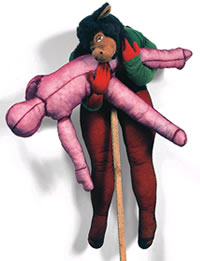 ‘The Messengers‘ is a retrospective exhibition covering four decades of work by the French artist Annette Messager. It is also apparently the first major exhibition of her work in the UK. Messager works with simple materials and found objects, using the kind of stuff that most of us would have around in our homes. The exhibition guide describes her work as questioning ‘the tacit rules of art and life: challenging the roles assigned to women; subverting identity; using unorthodox materials … taking as her sources popular and folk art, the rituals of daily living, mythology and fairytales’.
‘The Messengers‘ is a retrospective exhibition covering four decades of work by the French artist Annette Messager. It is also apparently the first major exhibition of her work in the UK. Messager works with simple materials and found objects, using the kind of stuff that most of us would have around in our homes. The exhibition guide describes her work as questioning ‘the tacit rules of art and life: challenging the roles assigned to women; subverting identity; using unorthodox materials … taking as her sources popular and folk art, the rituals of daily living, mythology and fairytales’.
On entering the first room, I was faced with a huge batlike creature painted onto the wall, its face made up of distorted photographs of human features (and not all facial features either). This creature was surrounded by other smaller creatures, also collages of photographic features and paint (‘Chimaeras’). The effect was both comic and disturbing, which I found to be a common feature of the subsequent works. In a corner of the same room was a collection of drawings entitled ‘The horrifying adventures of Annette Messager, Trickster’ which depicted various disturbing and often lurid situations encountered by a mythical adventuress. These are entirely a work of fiction by the artist, as she says in the exhibition guide – “I never recount my real life; these are never my true stories.”
An intriguing work for me was ‘Children with their eyes scratched out’, in which she had framed several found photographs of babies and children, upon which she had scribbled out their eyes with pen. Responding to the conventional cultural expectation that all women should want to be mothers, she collected these images to form her own imaginary album of ‘her child’. The act of violently scratching out their eyes she describes as making them more ‘truly’ her child. Arranged in circles around these images are smaller drawings made by the artist purporting to be drawings by this imaginary child, who likes to draw ‘Mummy’ as she goes about her daily life. For me, this piece questioned an important and often unquestioned assumption (all women want children) in a way that is playful, whilst also disturbing and disrupting ideas of conventional ‘real life’.
In ‘My Vows’, one of the pieces which explains why the entire exhibition took 2 months to hang, at least a hundred framed fragments of body parts hang suspended from strings so that the overlapped fragments form a circle. Close to, trying to make sense of these fragments to form a whole is an impossible and fruitless project, illustrating for me the the way identities are equally fragmented and often irreconcilable. Yet from a distance, these fragments cohere into a perfect circle suspended in space. The effect is striking, and illustrates for me the artist’s brilliance in displaying her work to fit the exhibition space. This attention to detail and positioning the work within the space is consistently managed throughout the show, so that you walk away knowing that you have just seen exemplary work from a top-class artist. Full marks also to the team at the Hayward – this exhibition must have taken a lot of work, and it does the gallery credit.
The show also contains some of her later work, which is on a much larger scale, filling rooms with theatrical installations such as the one in the Liverpool Biennial. Filling one room, large cartoon-like replicas of body organs constructed from colourful parachute fabric inflate and deflate in a choreographed dance, to the sound of whirring fans and rustling fabric. The effect was comic but also a bit creepy. There must be a word for ‘comic macabre’, and whatever that word is, Messager does it well and consistently. In another room, ‘Casino’ invites the viewer to sit down on a bench (very welcome, as I’d been on my feet a while by then) and watch as a sea of scarlet silk rolls through a door into the room like a vibrant sea. Lulled by the waves, you then become aware of lighted objects hidden beneath the ‘sea’, like an enchanted underwater town. Periodically, an illuminated clock comes into view behind the red silk, glimpsed through the door at the back of the room, creating for me a sense of timelessness rather than a reminder of the demands of time. The overall effect was hypnotic.
There was so much more that I could describe, but I’m hoping that if you are reading this and can get to London, you might be inspired to visit. It is well worth the time, and I’d suggest taking half a day to do it justice. It’s on at the Hayward until 25th May 2009.